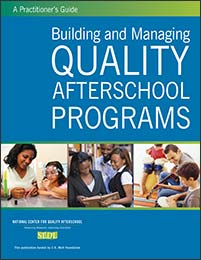A Practitioner's Guide: Building and Managing Quality Afterschool Programs
Authors: SEDL, compiled by Catherine Jordan, Joe Parker, Zena Rudo, Deborah Donnelly, Joni Wackwitz (editor), Shaila Abdullah (designer)
| Product ID: FAM-125 | Price: $34.99 from Lulu.com |
Available online: PDF
![]()
A Practitioner's Guide: Building and Managing Quality Afterschool Programs is designed to share with you the practices that can help you cover it all—great programming, terrific staff, positive relationships, and plenty of resources to lead and sustain successful afterschool programs.
What's Included in This Guide
Produced with the generous support of the C.S. Mott Foundation, this Guide is intended to share the insights of SEDL's National Partnership for Quality Afterschool Learning (the National Partnership) as well as information about both the academic and the organizational and management practices that successful afterschool programs use. We have organized these practices into the following four focus areas:
- program organization
- academic programming practices
- supportive relationships in afterschool
- achieving program outcomes
Within each focus area, we describe the key practices of successful programs. In addition, we provide a Quality-O-Meter tool to help you reflect on your practices. This tool incorporates what the National Partnership learned in its research as well as knowledge from its numerous content experts. We then provide a Planning for Action tool to help you document plans for implementing practices to increase your program's quality. This tool is a structured way to organize and manage the implementation of any new or enhanced afterschool practice.
How Practitioners Can Use This Guide
Anyone associated with what is often referred to as expanded learning time—whether afterschool, before school, Saturday, extended day, extended year, summer learning, or any other nontypical school-day learning situation—will find this publication useful. In particular, this Guide can help build the knowledge and skills of a variety of audiences. With individuals, leaders can use this Guide as a self-study of the key practices that contribute to a successful program. With groups, leaders can use it to guide discussions and decision-making processes in a professional learning community. This Guide can serve as a continuous improvement and planning tool for staff or a program advisory group. Furthermore, it can be used to inform the ongoing discussions between school-day programs and afterschool or other expanded learning programs.
"I would recommend this resource as a tool to focus ideas around basic concepts, approaches to curriculum, and involvement and cooperation with school staff."
––N. Ellison
"I would recommend this resource to others as it is a comprehensive tool for assessing afterschool programs. It also have a planning component which will focus the grantees on what they need to imorove."
––User
"I would recommend this resource to anyone interested in building an afterschool program."
––User
"The information in the document was extremely helpful to me in the management and overall development of my after-school program."
–– User
"It is a great professional development tool for us and for project directors to use with their staff."
––User
"As a new director, I am constantly looking for resources that will improve our organization and our professional development. This document will provide a framework for assessing where we stand in meeting our goals."
––User


